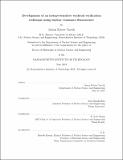Development of an isotope-sensitive warhead verification technique using nuclear resonance fluorescence
Author(s)
Vavrek, Jayson Robert.
Download1134982479-MIT.pdf (6.594Mb)
Other Contributors
Massachusetts Institute of Technology. Department of Nuclear Science and Engineering.
Advisor
Areg Danagoulian and R. Scott Kemp.
Terms of use
Metadata
Show full item recordAbstract
Nearly three decades after the end of the Cold War, nuclear arms control remains a pressing global issue. Despite obligations under the Treaty on the Non-Proliferation of Nuclear Weapons (NPT) to make 'good-faith efforts' to disarm their nuclear arsenals, the United States and Russia still maintain thousands of nuclear warheads. Progress towards complete disarmament has been gradual due to a variety of socio-political barriers, but future efforts towards nuclear arms reduction will face an additional technological hurdle: no technology exists to verify that warheads slated for dismantlement are authentic without revealing any sensitive weapons design information in the process. Despite several decades of research, no technology has solved this apparent paradox between information security and confidence in a warhead verification measurement. Recent work by Kemp, Danagoulian, Macdonald, and Vavrek [1] has produced a novel physical cryptographic verification protocol that approaches this treaty verification problem by exploiting the isotope-specific nature of nuclear resonance fluorescence (NRF) measurements to verify the authenticity of a warhead. To protect sensitive information, the NRF signal from the warhead is convolved with that of an encryption foil that contains key warhead isotopes in amounts unknown to the inspector. The convolved spectrum from a candidate warhead is then statistically compared against that from an authenticated template warhead to determine whether the candidate itself is authentic. Since only the final, convolved spectra are observable, and the detailed foil construction is unknown to the inspector, sensitive information about the warhead is encrypted by physics rather than by software or electronics. In this thesis, we performed proof-of-concept NRF warhead verification experiments at the High Voltage Research Laboratory (HVRL) at MIT [2]. Using high-purity germanium (HPGe) detectors, we measured NRF spectra produced by the interrogation of proxy 'genuine' and 'hoax' objects by a 2.52 MeV endpoint bremsstrahlung beam. The observed differences in NRF intensities near 2.2 MeV indicate that the physical cryptographic protocol can distinguish between proxy genuine and hoax objects with high confidence. Extrapolations to thicker warheads and dedicated verification facilities indicate that realistic warhead verification measurements could be made on the order of hours. In support of these and future NRF experiments, we also improved and benchmarked the G4NRF code for the simulation of NRF in Geant4 [3]. We first constructed a high-accuracy semi-analytical model for the expected NRF count rate in both simple homogeneous and more complex heterogeneous geometries. We then performed Geant4+G4NRF simulations with these geometries, and found agreement in NRF rates predicted by the semi-analytical model and observed in the simulation at a level of ~1% in simple test cases and ~3% in the more realistic complex scenarios. These results improve upon the ~20% level of the initial G4NRF benchmarking study and establish a highly-accurate NRF framework for Geant [4]. Finally, we conducted a G4NRF validation study using the NRF data taken during the warhead verification experiments [4]. Agreement between the absolute NRF count rates observed in the data and predicted by extensive Geant4+G4NRF modeling validate the combined Geant4+G4NRF model to within ~20% in the 238U NRF transitions and 9% in 27Al, for an average 14% discrepancy across the entire study. Additionally, agreement between the model and data in relative NRF rates is found at the level of .5%. Such agreement in both relative and absolute analyses provides good predictive capability for the design and analysis of future NRF experiments using G4NRF, whether for warhead verification or other applications.
Description
This electronic version was submitted by the student author. The certified thesis is available in the Institute Archives and Special Collections. Thesis: Ph. D., Massachusetts Institute of Technology, Department of Nuclear Science and Engineering, 2019 Cataloged from student-submitted PDF version of thesis. Includes bibliographical references (pages 93-99).
Date issued
2019Department
Massachusetts Institute of Technology. Department of Nuclear Science and EngineeringPublisher
Massachusetts Institute of Technology
Keywords
Nuclear Science and Engineering.